Known for its deadly stories, stunning marine life, and unique topography, the Blue Hole Dahab is a spectacular diving spot in Egypt. Freedivers, technical divers, and first-time divers make their way to this part of the country for an adventure-filled experience.
One of the 5 most famous blue holes in the world, the Blue Hole Dahab stands in stark contrast to Egypt’s ancient pyramids. In addition to adventure sports, Dahab has a host of things to offer to excited travellers that make their way here.
In my current blog, I will let you know everything about the blue hole. Through the medium of my travel writing, I intend to assist you in organizing a fun-filled day here.
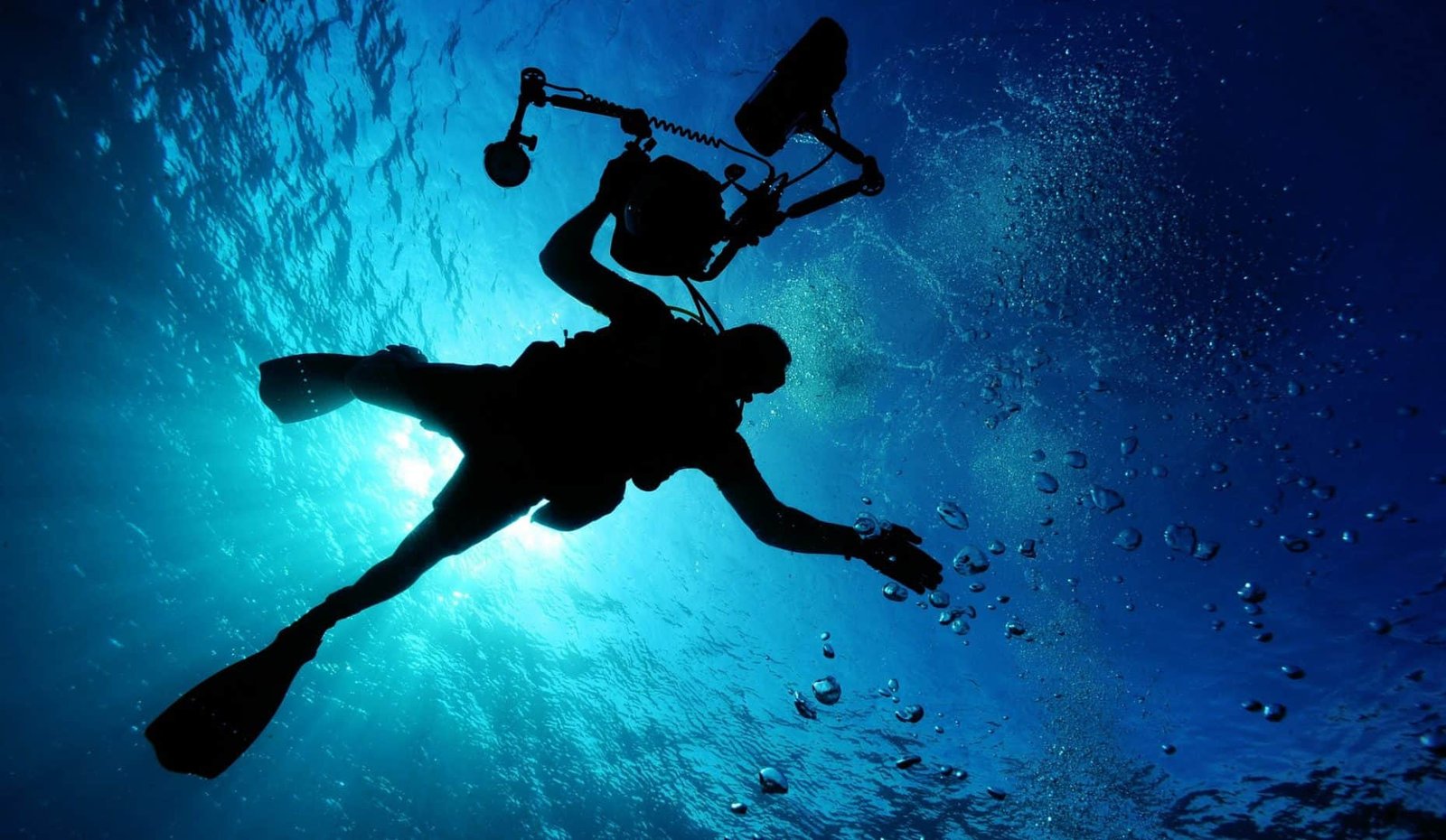
Diving for me is like nirvana. What’s special about the blue hole is that it’s not just a diving destination, but also a place for biking, hiking and snorkelling. Its presence in Egypt makes it very cheap and affordable for diving maniacs from around the world.
Blue Hole Dahab: An Overview
Blue Hole Dahab is a must-visit destination for adventure lovers visiting Egypt. Not only does the place offer wonderful opportunities to explore marine life, but it is also a great one day visit for travellers from nearby regions.
Before I go into the details of exploring the Blue Hole Dahab, here’s a brief overview:
| Location
10 kilometres north of Dahab, on the east coast of the Sinai Peninsula |
| Best time to visit
April-May, September-November |
| Currency
The currency used in Egypt is the Egyptian Pound. It is written as EGP or E£. The conversion rate in terms of EGP (Egyptian Pound) and USD (American Dollar) back when I visited Egypt was as follows: 1 USD = 16.57 EGP |
| Official language
Arabic |
| Getting there
Rented car, bus, hitchhike |
| Food
A number of cafes and shacks are available. Most of them serve delicious, and affordable Egyptian and European food. |
| Stay |
| Trip highlight
Diving and snorkelling |
| Other things to do
Hiking, mountain climbing, camel rides, horse rides, or simply chilling by the sea |
Dahab has so much to offer to visitors, that no amount of time is going to be enough to do justice to this majestic town. Read on, and find out everything it has to offer. Choose whatever floats your boat the best.
P.S: Non-swimmers, there’s something for you too.
What are Blue Holes and Why are They Named So?
In case you’re hearing this term for the first time, don’t worry. You’re certainly not the only one. Let me feed your curiosities.
When observed from high altitudes, blue holes are of a substantially deeper colour than the surrounding waters. Most of the time, these holes are a mix of freshwater and saltwater.
In case you’re still confused, think of it as a vertical cave or a vertical tunnel. These caves eventually connect to the open sea.
How was the Blue Hole Dahab formed?
Most blue holes were formed during previous ice ages. In those days, water levels were at least 100 meters lower than they are in the contemporary scenario. With the ice melting, many caverns started submerging deep at the bottom of the sea. Eventually, some of these caverns’ ceilings collapsed, creating deep holes to be filled by water. Additionally, years and years of erosion and corrosion played a big role. This is how the blue hole Dahab came into existence, and sooner than later, it became a source of adrenaline rush for divers.
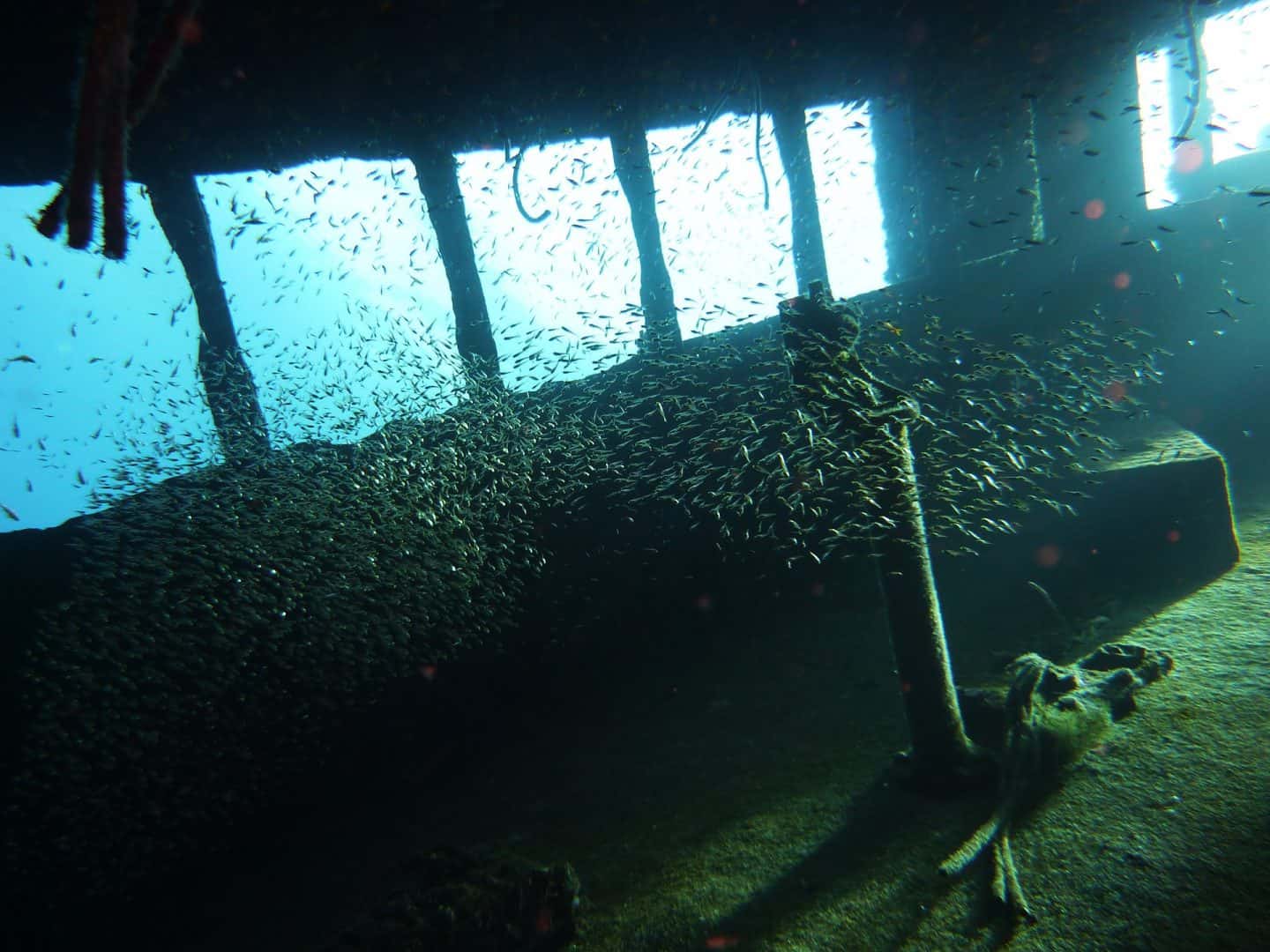
While Dahab is popular for the blue hole, there are a lot of other wonders to discover underwater. The list is endless. This is a photograph of a shipwreck in the Red Sea. Imagine diving sites like these – it’s exhilarating, eerie, and sombre, all at once.
Blue Hole Dahab – The Deadly Diving Magnet
One of these blue holes turned out to be what is now known as Blue Hole Dahab. In recent years, it has been seen as one of the most popular diving destinations in the world.
Popularly known as a divers’ cemetery, a number of adventurers have lost their lives while exploring this blue hole in the Red Sea.
| As a matter of fact, most deaths have not occurred due to natural calamities or unexpected conditions of the sea. Most of the causalities have occurred on occasions when divers have overestimated their skills and not respected the sea.
A different set of equipment, a different mix of gas (breathing gas consisting of oxygen, helium and nitrogen), and a lot of mental preparation goes into safely diving into the blue hole Dahab. Unfortunately, overconfidence drives a number of divers to take the leap despite not being completely equipped for the same. This is what leads to tragedies. |
The blue hole in Dahab is about 100 meters deep, and this is really deep for anyone who isn’t a technical diver.
P.S: A technical diver is someone that engages in diving for non-professional purposes. They are much more trained and equipped to face hazards and risks.

There are boards like these scattered across the coastal areas. The idea is to request visitors to respect the sea and be safe. A number of divers have lost their lives while diving into the deadly blue hole. Please know your limits and exercise complete caution.
In a nutshell, the blue hole Dahab is most certainly dangerous. However, all one needs to do to be safe is to know their limits, draw boundaries, and respect the sea.
The Memorial Stones
More than 100 people have died at this dangerous diving spot. It’s a scary thought, and whenever it does happen, professional technical diver Tarek Omar pulls their bodies back to the surface. The beach has about 15 memorial stones dedicated to divers that breathed their last breaths in the Red Sea.
Fortunately, these blue hole Dahab diving deaths have now reduced in number because of stringent checks and more security.
Diving in the Red Sea is for Everyone
In case you’re intimidated by now, don’t be. Diving adventures in Dahab are not restricted to the blue hole. Even if you’re someone who has NEVER gone scuba diving before, Dahab will welcome you with open arms. If I had to put it in one line, I’d say that Dahab has something for everybody.
Read on to find out everything you’d want to know about diving in the Red Sea.
Discover Scuba Diving for Recreational Purposes
Not everyone who goes diving takes it to a professional level. If you’re someone who simply wants to breathe underwater, and has a glimpse into the beautiful marine life, you could opt for a discover scuba diving deal.

Your first-time scuba diving might be tantalizing. The very first time you have to take the plunge and jump into the sea can be scary. But, remember that you’re well-equipped and are accompanied by an experienced guide. Don’t think too much, go for it!!
It generally takes about 7-8 hours and includes:
| Basic theory |
| Practising a few skills in shallow waters |
| An open water dive |
Once again, no diving experience is required for this wonderful experience. Do not hesitate much, and go for it. Before you know it, you’ll be underwater – the sound of bubbles, and the underwater life will make you feel like you’re in another world.
Taking it a Step Further: Scuba Diving Courses
Dahab has many diving schools that offer entry-level as well as advanced open watercourses. With an entry-level open water course, you can sign up for dives at a number of sites in Dahab. At this level, you can go as deep as 18 meters underwater.
Most diving schools in Dahab would push you to enrol for the next level – the advanced open watercourse. This is because a number of sites in Dahab – especially the popular ones would require you to have an advanced level certification. With this certification, you can dive up to 30 meters deep.
The Real Deal: Diving the Blue Hole Dahab
Finally, let’s talk about what it takes to dive into the blue hole, and what it is like.
For starters, there are 2 different routes to enter the blue hole:
| Through El Bells – Only advanced divers can enter here since you can only exit at about 27 meters. The bells are like a chimney – so narrow that only one diver can descend at a time. The sound of the divers’ tanks touching the walls has given it the name ‘El Bells.’ |
| Dive right into it – Those with an entry-level certification can dive right into the blue hole, and follow the magnificent wall of all sorts of colourful corals. |
Now, how deep into the hole you can go will be decided by the level of certification you have. For example, at about 56 meters is an archway. This arch connects the blue hole to the open sea and is something that appeals to adventurers. However, not even advanced divers are allowed to make it here.
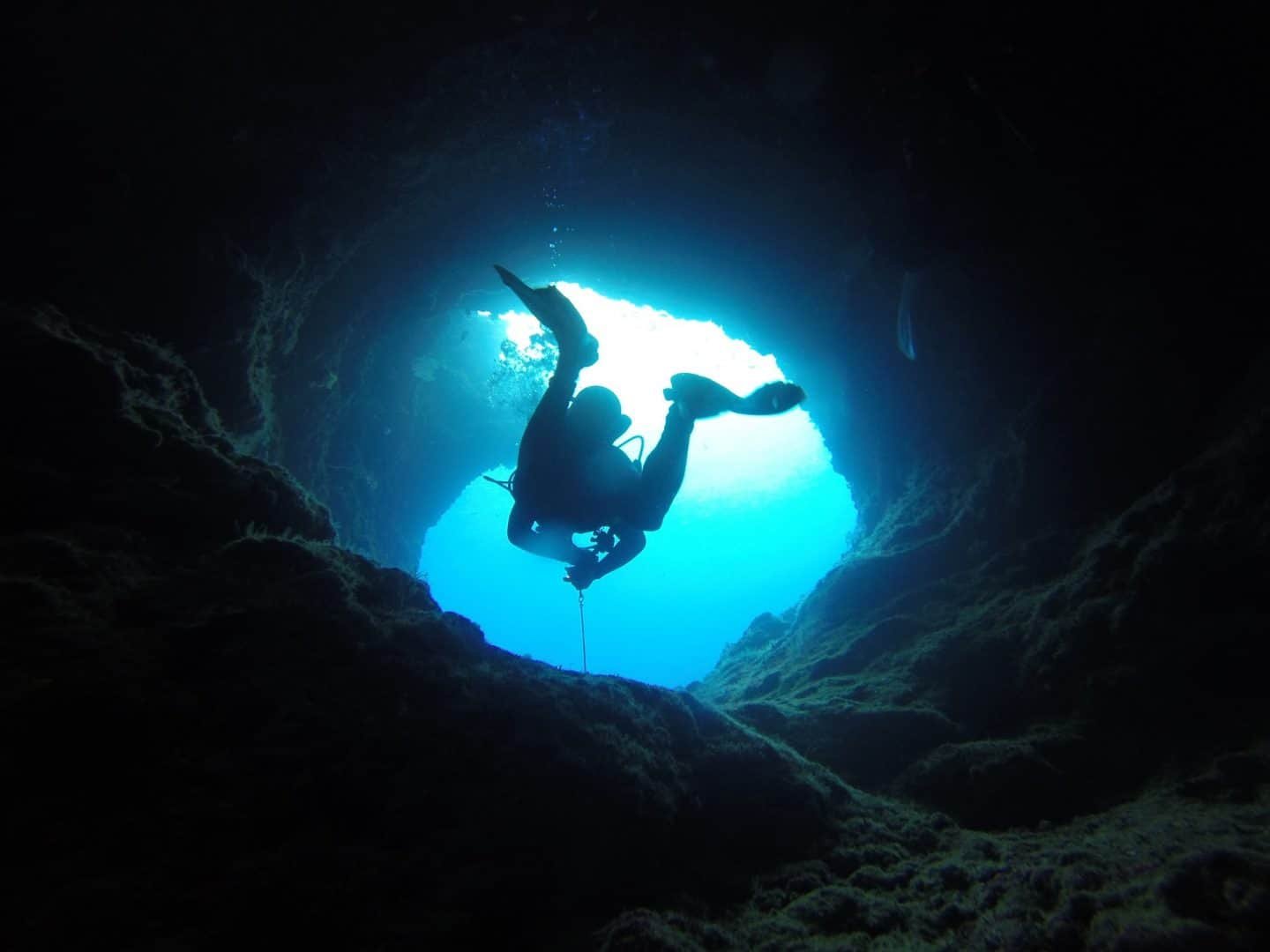
Diving the blue hole is certainly a spiritual experience, However, but crossing your boundaries can have really bad consequences. There are high chances of nitrogen narcosis – an alteration of consciousness at really deep levels, which could be fatal.
Only technical divers and highly experienced free divers are permitted here. You are required to have completed the TDI Trimix diving course, which extends your depth range.
With an advanced level certification, however, you would be able to explore a fair majority of this marvellous wonder.
What Can I Expect to See Underwater?
Marine life. We’re talking rare, exotic, and abundant marine life. Schools of snapper fish, eels, milkfish, stingrays, sharks, dolphins, frogfish, turtles, etc live in the waters of the red sea. Simply put, if you’ve seen the movie ‘Finding Nemo’, brace yourself for watching the HD live version of all of your favourite fish, including the clownfish itself, Nemo.
In addition to the abundant underwater life, these waters house:
SS Thistlegorm
This is a British freighter that will transport you to the World War II days. It sank into the sea in 1941 and carried war equipment such as machine guns, bombs, tanks, etc.
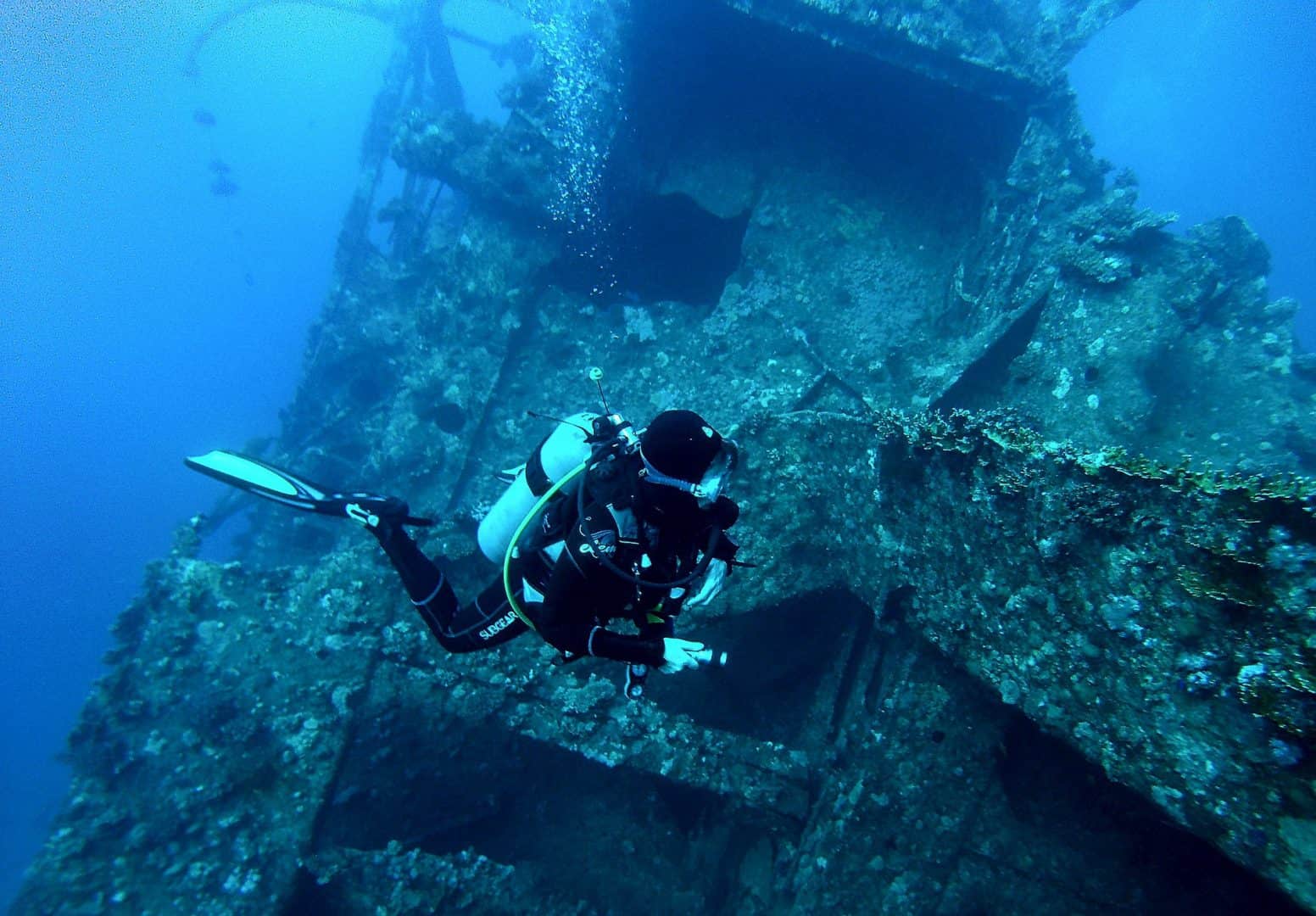
A completely new world exists at the bottom of the sea. In addition to the marine life, you’ll be exposed to wrecks, caves, and museums. This is a photograph of a diver marvelling at the shipwreck. It stands in stark contrast to the vibrant marine life.
Note: Such kinds of diving trips will cost more than the regular ones.
An Underwater Museum
The I-Dive Tribe, a group of professional divers have installed some breath-taking eco-friendly sculptures underwater. The goal is to spread awareness about environmental conservation. This is done by means of the sculptures – depicting the birth and growth of our dying coral reef.
The Caves
Yes, caves can be found underwater too – how cool is that? There are principally 2 caves located not very deep inside. These caves house beautiful corals and are extremely wide making it a great spot for beginner level divers.
It is also a great spot to get some cool pictures in your diving suits.
Snorkelling Your Way Through the Red Sea
The good news is that you don’t always have to go too deep to see the life that lives underwater.
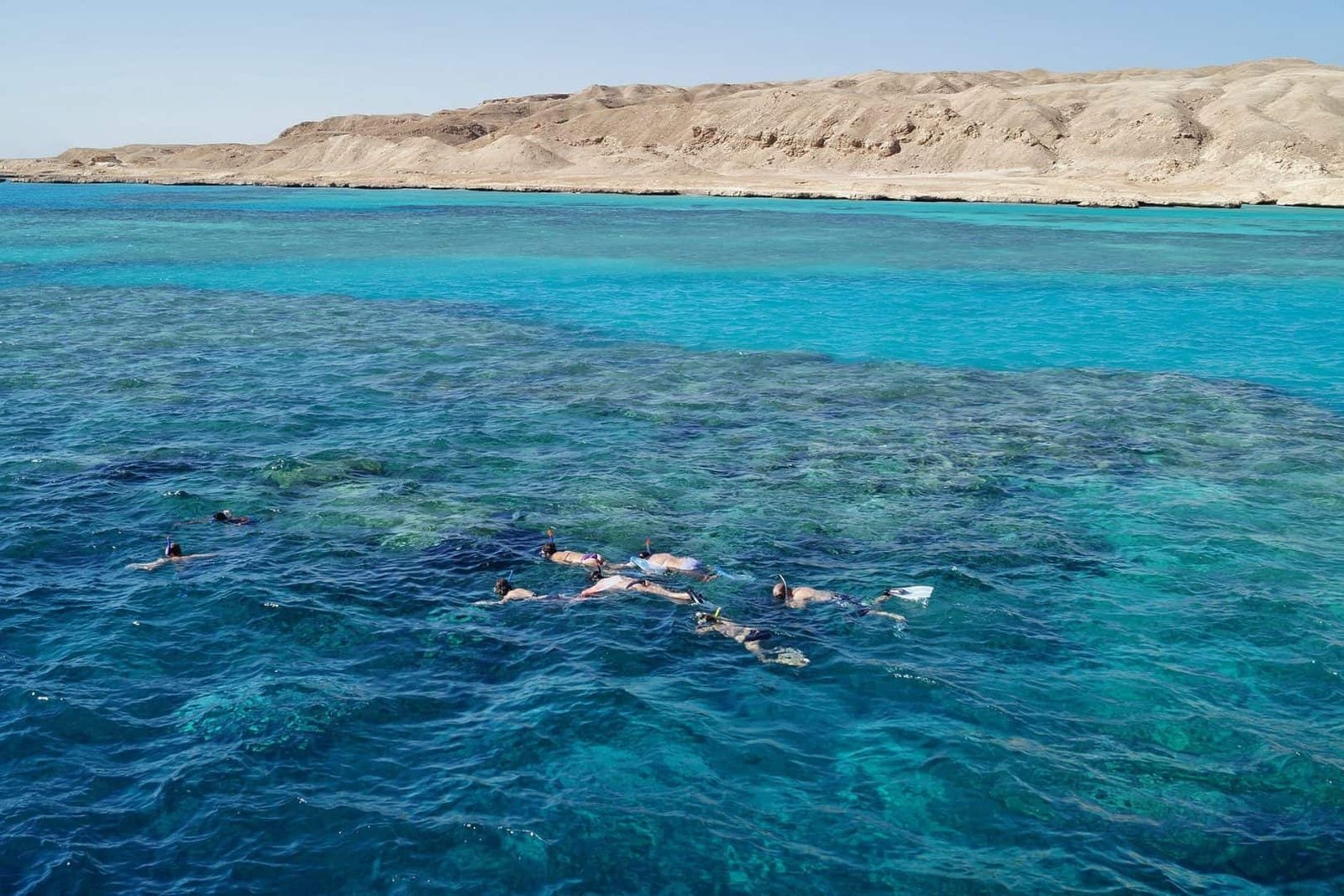
Snorkelling in Dahab is as beautiful as it looks in this picture. You’ll learn that a lot can be seen from the surface itself. All you need to do is put on your diving mask and your snorkel, and dip your face into the clear blue waters. Get exposed to a new world.
Some sights in Dahab that you must definitely check out for snorkelling are the canon, Ras Abu Galum, Lighthouse reef, eel garden, Islands and Napoleon Reef.
You can either carry your own snorkelling equipment or you can rent it out at one of the many diving schools. A lot of travellers also prefer to take a safari that includes snorkelling, camel ride and lunch. I would definitely recommend this to fellow travellers.
Dahab Egypt: How Much Does a Diving Adventure Cost?
There are more than 50 diving schools to choose from in Dahab, so prices are definitely going to vary. However, the following are the average prices for diving in the Red Sea.
| Discover scuba diving – 800 EGP (48.5 USD) for 1 dive, 1115 (67.5 USD) EGP for 2 dives (for those with no previous diving experience) |
| 3 guided dives in a day – 1400 EGP (84.9 USD) |
| Entry-level open water diving (OWD) – 5300 EGP (321 USD) |
| Advanced open water diving (AOWD) – 4000 EGP (242.5 USD) |
This is how much you can expect to pay for diving courses in Dahab. Please do not go to diving schools that are oddly cheap. They might as well be safe, but diving is something you do not want to take any risks with. Do not put your life in danger to save a few pounds.
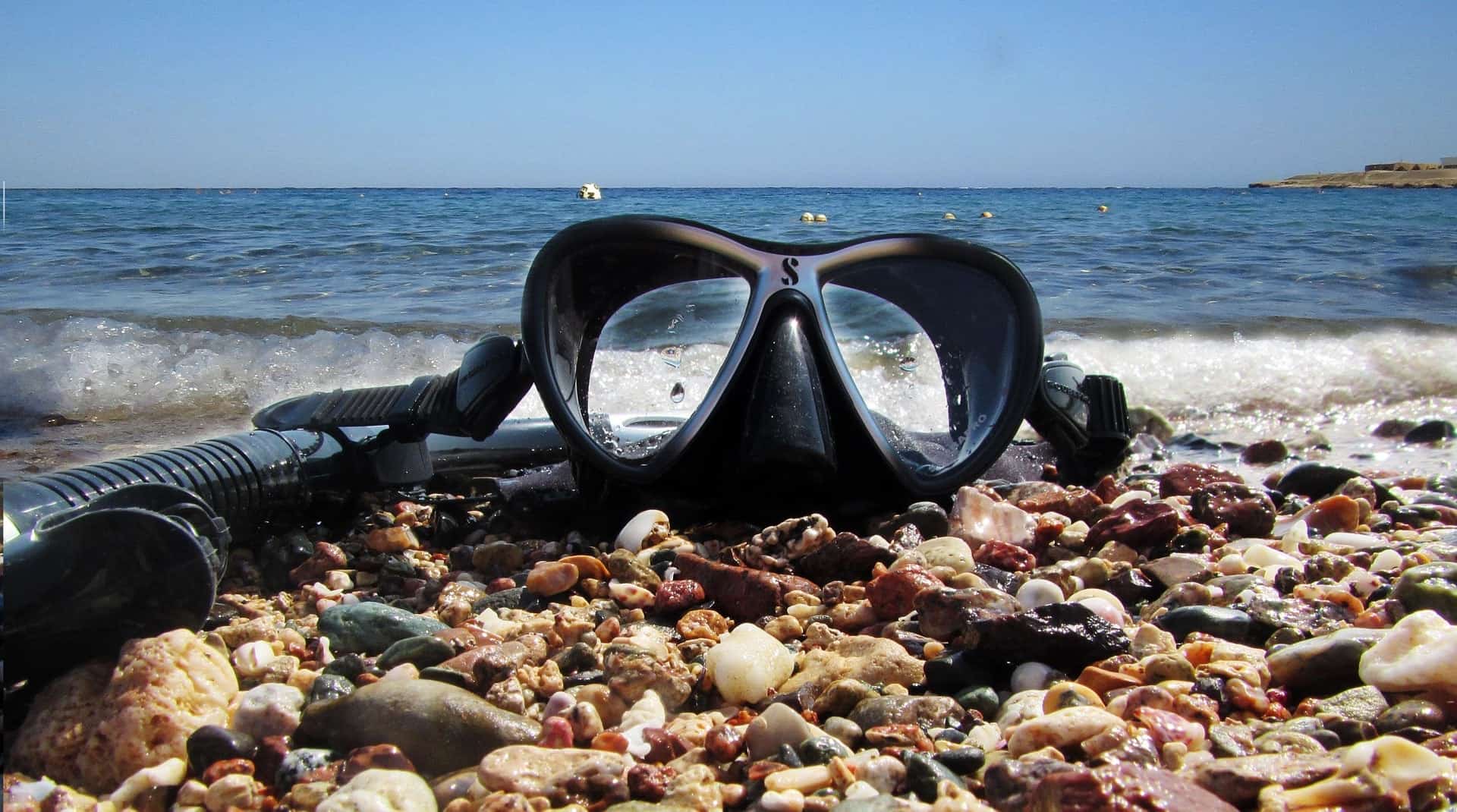
Dahab not only offers all sorts of dives, courses, and packages but also the opportunity to rent equipment. You can rent it per dive, per day, or per week. Ensure that you know exactly how to use it. If not, clear it out before you head into the sea.
Equipment Rental
Equipment rental varies quite a bit in terms of its prices. To be sure of its quality, it would be better for you to do some asking around and reading up on reviews on the internet.
However, prices could be somewhat averaged out as follows:
| 1 dive: 558 EGP for full equipment |
| 4 dive pack: 1490 EGP for full equipment |
You will find all sorts of offers, packages, and deals in the dive schools of Dahab. Make sure you explore your options well before making a deal. Most importantly, be sure of the organization’s credibility – do your research and be safe.
Camels and Diving – An Odd Link?
Maybe not.
We have all heard about camel riding in the Sahara, or in the dunes of Rajasthan. However, have you ever imagined being taken to your diving spot on a camel? This is something that Dahab offers to its visitors.
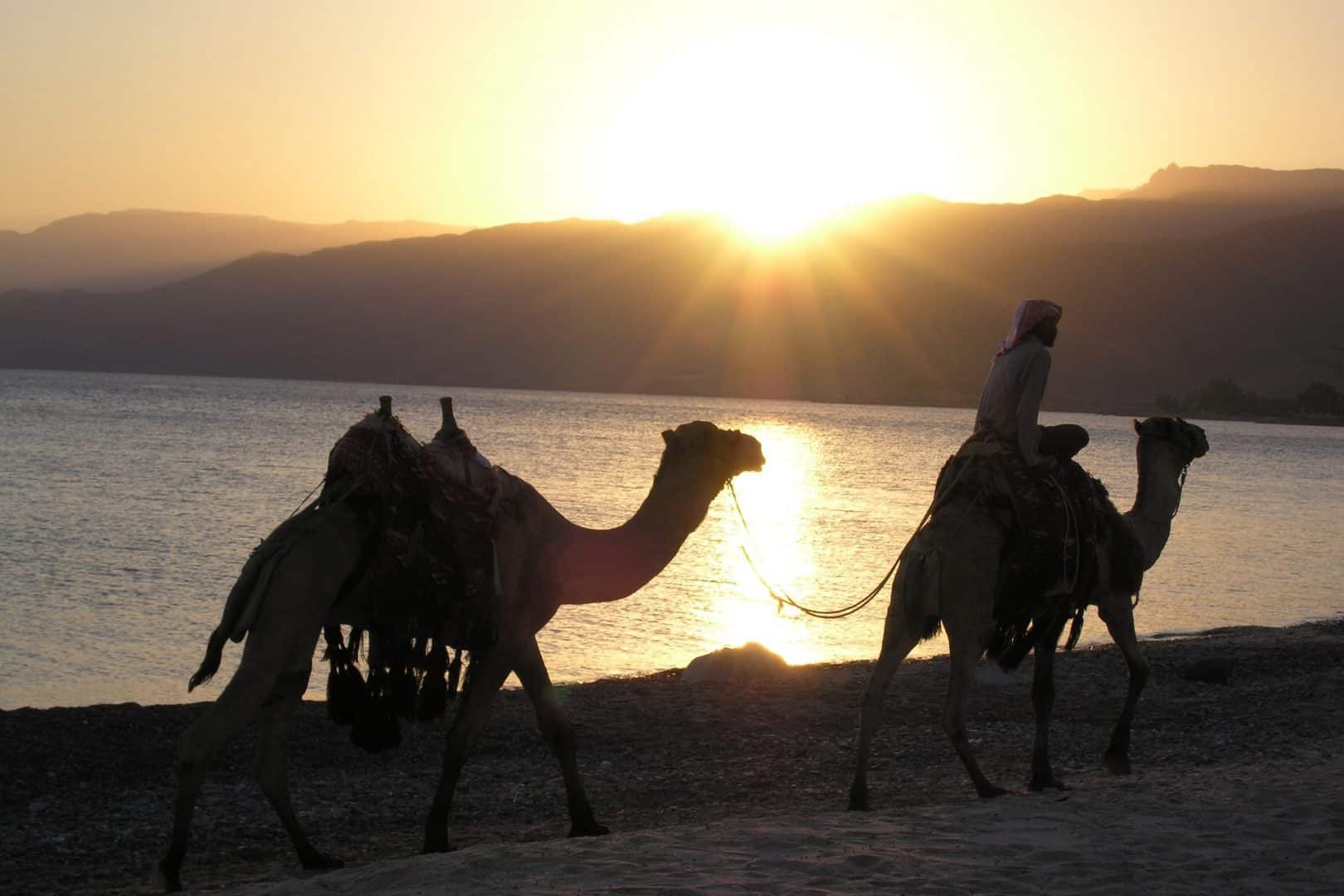
Egypt is truly a miracle. Really, is there anything cooler than going on a camel ride by the dead sea? The image of divers and camels simply doesn’t fit together in your head, but in Dahab, it does. This is a once in a lifetime opportunity.
| Gabr el Bint and Ras Abu Gallum are 2 diving sites in Dahab that can only be accessed by boat or by camel. While the former comes cheaper, you do not want to miss out on the camel ride, trust me. |
In case you do not want to go diving, there are camel rides available in other parts of Dahab too. You could enjoy a bumpy ride to the blue lagoon and watch the sun go down, or visit Wadi el Bida for elevated views of the town and the sea.
Blue Hole Dahab for Non-Swimmers – Other Things to Do
Dahab offers a host of activities that have nothing to do with water. Some of them are:
Climb Mount Sinai
Standing tall at 2,285 meters, Mount Sinai appeals to hikers and adventurers. What’s special about this trek is that it begins at night. The goal is to make it to the top by early morning and watch the sunrise over the Sinai peaks.
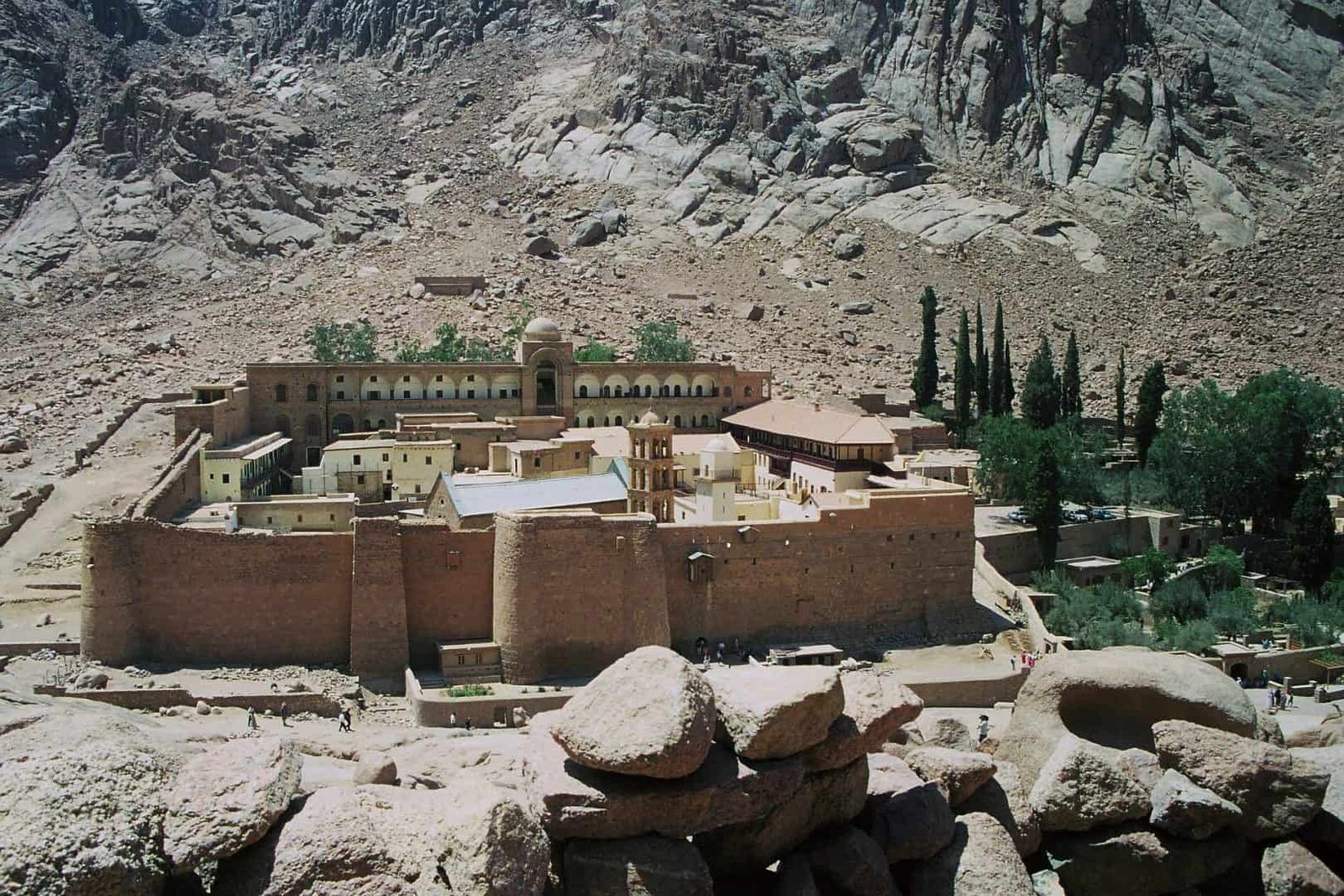
Just when I was thinking Dahab is a little too varied to be true, I was told about St. Catherine Monastery at the foot of Mt. Sinai. This is one of the oldest working monasteries in the world & is a rare wonder. Do stop by if you hike the beautiful mountain.
Explorations on a Horseback
Just like exploring the area on a camel, you can also do so on a horseback. There are a number of horse-riding tours you can choose from. While some would take you to the blue lagoon, others would have you galloping through desert canyons and oases.
Munching and Drinking
A number of stalls, shacks, and cafes line the beach in Dahab. What’s exciting is that the seating by Blue Hole Dahab isn’t one of the traditional umbrellas and sea chairs. It’s in the form of Arabian style seating – in wooden shacks or cafes.
For some delicious filter coffee, pastries, and bread, do visit Ralph’s German Bakery.
If the idea of sipping on cocktails while watching the beach life go by appeals to you, head to Yalla Bar. This place is known to have fostered friendships and has treated travellers from across the globe, to great cocktails at great prices.
Other Adventure Sports
Chances are that you love adventure sports and adrenaline-inducing activities, but not diving in particular. If that’s the case, you could try your hand at windsurfing, or simpler activities like quad biking.
Cycle Around Dahab Town
Hopping onto a bicycle and exploring the region can make for a great outdoor adventure. Actually, biking is one of the most common and easiest ways of commuting in the town of Dahab. It is also a great way to let the beautiful views of the sea sink in.
You can rent out a bicycle at a number of shops in Dahab (ask around at your hostel too). It will set you back roughly 100 EGP for a day. You can also rent it out on an hourly basis.
Backpack Checklist for a Trip to the Blue Hole Dahab
Dahab is extremely varied when it comes to various terrains and landscapes.
Furthermore, you might want to engage in all sorts of activities – diving, hiking, horse riding, etc. Packing your bag for such a trip might not be the easiest thing to do.
| Clothing – Quick dry t-shirts and shorts, long pants, a windcheater, swimwear, a travel towel, a hoodie (if you’re going in the winters) |
| Footwear – A pair of slippers, and a pair of comfortable hiking shoes. Alternatively, simply carry a pair of comfortable walking sandals |
| Others – Toiletries, sunglasses, sunblock, hat, mosquito repellent, anti-fog, personal medication |
| Electronics – Portable charger, camera, camera housing, waterproof cameras like GoPros |
Additionally, if you have any sort of diving or snorkelling equipment, do carry that.

Packing a bag for locations like these is tricky. Fortunately, Dahab is an easy place to be in. It is also used to having travellers. So, don’t stress about missing out on anything important. You should be able to buy most things here.
Dahab Blog: Budget Accommodation
Thanks to the high inflow of travellers into Dahab, a number of budget options for stay are available in Dahab.
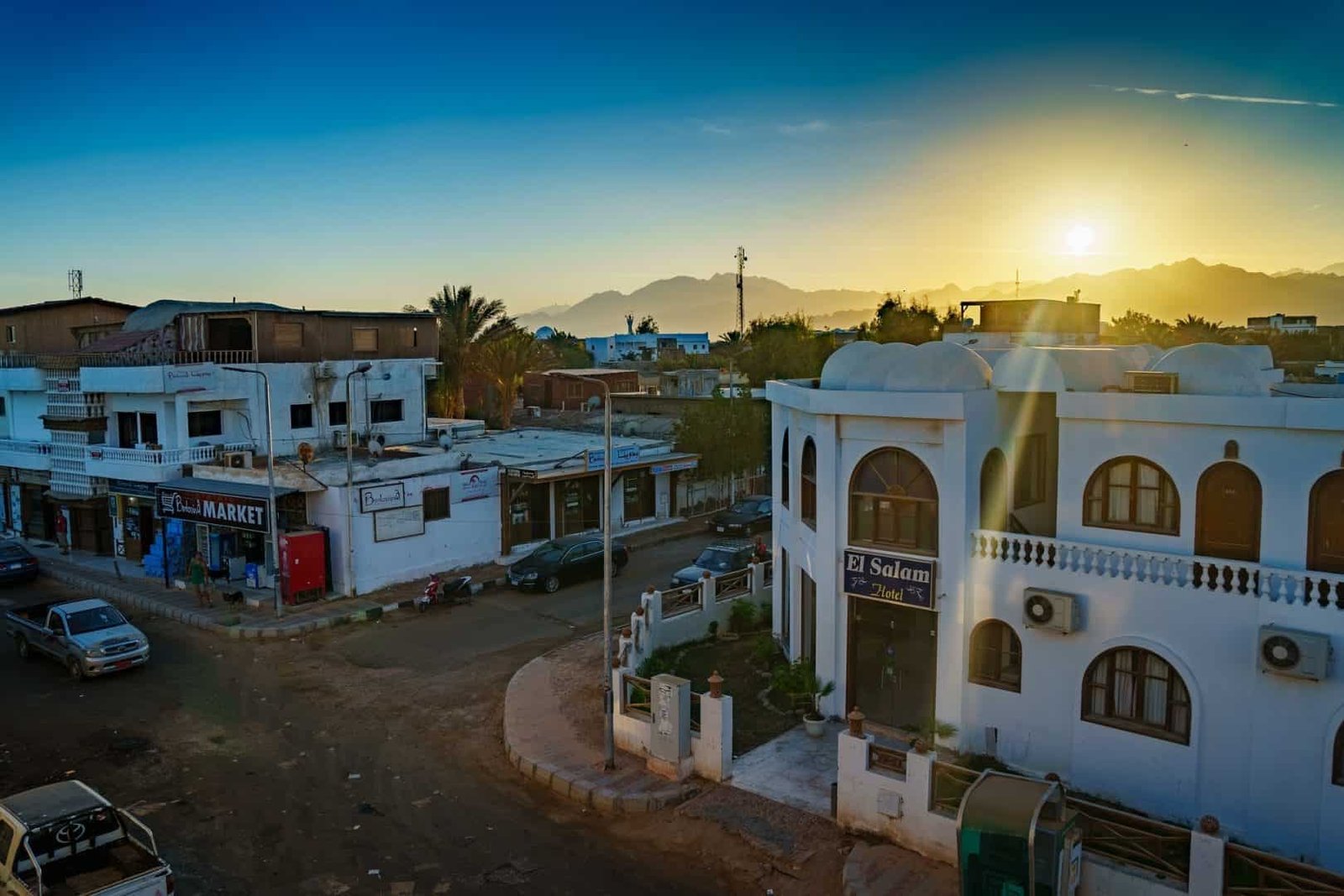
Dahab, a small Sinai town has slowly gained popularity due to its deadly diving stories. It is turning into a hipster town frequented by backpackers and solo travellers. Additionally, people are warm and caring. You must spend at least one night here.
Here are 2 places you could stay if you don’t want to burn a hole in your pocket:
| Dahab Plaza Hotel (105 EGP per person per night)
Single beds available Free breakfast served Ironing facilities available Lockers available Free Wi-Fi |
| Penguin Village Hotel (110 EGP per person per night)
Great location Single beds available Lockers available Free Wi-Fi Currency exchange |
There are several other options that are suitable for solo and budget travellers. Looking for a cheap option would be ideal, for you’re going to spend most of your time out in the sea.
Dahab Egypt Weather: Best Time to Visit
If you’re planning a trip to Dahab, you would most certainly want to go diving. So, I’ll lay down the most suitable time of the year to go to the water town for adventure sports.
Overall, Egypt treats its travellers to pleasant temperatures throughout the year. So, although no time of the year is unfavourable to visit, there certainly are months that are ideal.
The Winter months (December to March) in Dahab get really cold. At no point of the day is the water warm. Avoid this time of the year, for you do not want to be hiding under your blankets in your hotel room.
On the other hand, summers (June-August) could get really hot. The sun is at its peak, and you will not be able to do without constant dabs of sunscreen. That being said, this is also the best time of the year to spot exotic and abundant marine life.
Typically, the best time to visit the Blue Hole Dahab is from April to May and September to November. This is when average temperatures hover around 22-25°C. It is not too cold, not too warm, and divers are happy to be neglected by the grey clouds.
How to Reach the Blue Hole Dahab?
Getting to Dahab is much easier than you think it must be. Being a popular backpacking destination, a number of cheap ways to get to this coastal town have come up.
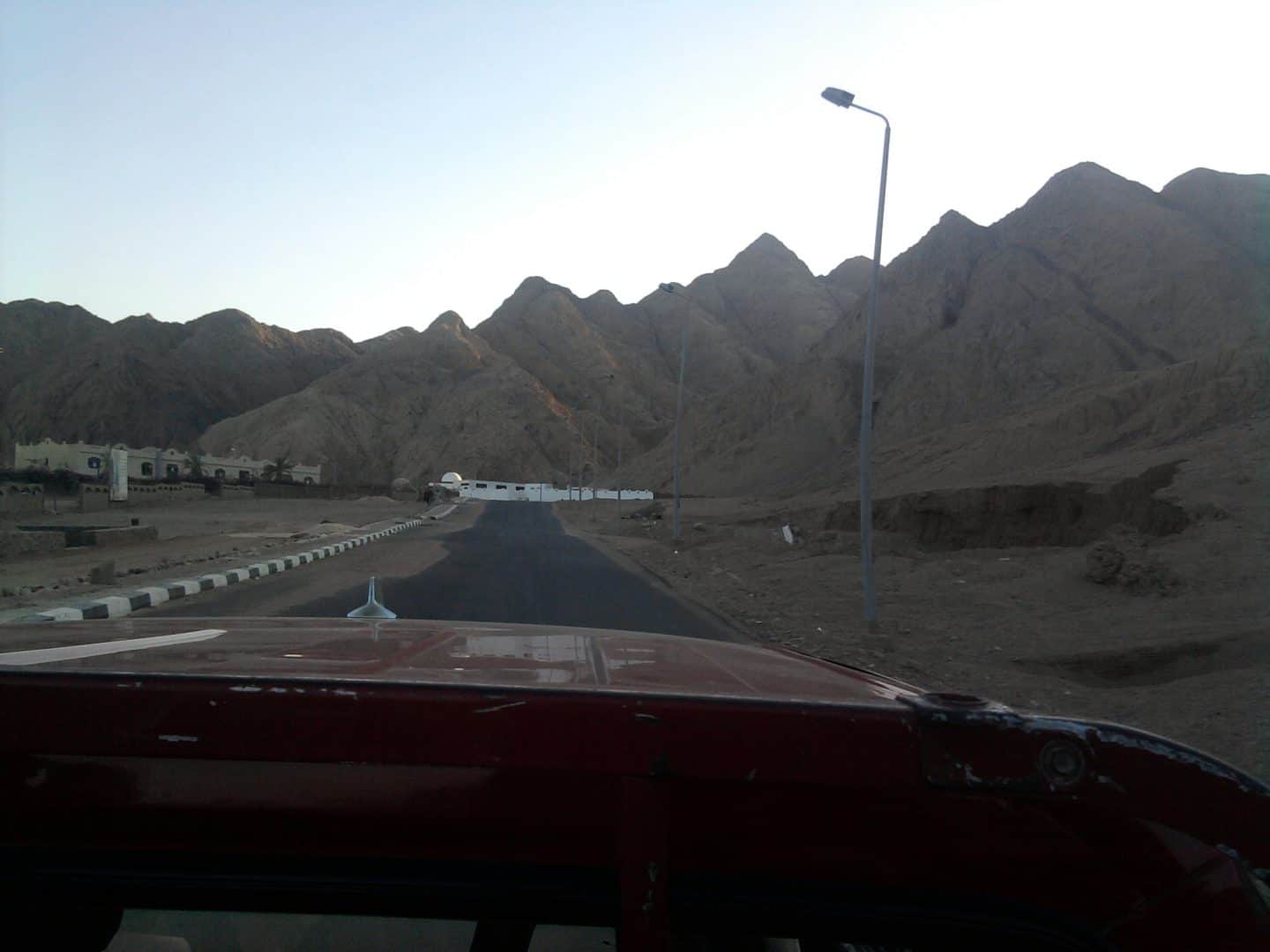
The roads to Dahab are beautiful. They’re bumpy in parts, but glaring at the ever-changing landscapes makes it worth it. I went to Dahab in a jeep but there are more options you can choose from, as per your budget, convenience, & time constraints.
No matter where you’re coming from and how you’re coming from, your journey will be divided somewhat like this:
Getting to Sharm
Sharm is a beautiful Egyptian town that lies around 100 kilometres from Dahab. It is home to beaches, clear blue waters, coral reefs, and an international airport. Whether you’re coming from other parts of Egypt or from another country altogether, there are 2 ways to reach Sharm.
| By bus
Buses are a popular and cheap way of commuting long distances in Egypt. A number of service providers offer buses that take you to Sharm from Cairo, Taba, etc. You can look up Go Bus or East Delta – fares and timetables are available online, and they’re generally hassle-free. Tickets are reasonable, making them a great option for budget backpackers. Just to give you an idea, a 10-12-hour bus from Cairo to Sharm would cost you anywhere between 100-250 EGP, depending on the quality/luxury. Note that these buses will halt at a number of military checkpoints. Do not get scared if an official or two hops on to your bus for investigations. They’re simply doing their job. All you need to do is keep your passport (for foreigners) or ID (for locals) ready. Also, sufficient stops for food and washrooms will be made. Tip: Reach the bus station (point of departure) 30 minutes prior. This will give you sufficient time to locate your bus, have your luggage boarded, and buy some snacks from nearby kiosks if need be. |
| By plane
Alternatively, take the flight. Since Sharm El Sheikh is an international airport, the connectivity is great. Internal flights are not too expensive, but obviously, cost much more than buses. |
So, do not get intimidated by all the scary things you’ve heard about bus journeys in Egypt. Sure, the roads are not the best you could ask for, but overall, it’s a smooth journey.
From Sharm to Dahab
Whether you take the bus or the flight, the second leg of your journey would involve getting from Sharm to Dahab. Now, there are multiple options available:
- Taxi all the way – However, this is would be unnecessarily expensive.
- Bus – Although not many know of this, buses run between Sharm and Dahab at intervals of one hour. Ask any local to guide you to the bus station. If you’re at the airport, take a taxi to the bus (do not pay more than 60 EGP). Finally, board a bus that will take you to Dahab – the journey duration is roughly 90 minutes and will set you back just 25 EGP.
- Hitch a ride – Walk to the main road, and try your luck at getting a free ride. In addition to locals, there are also tourists going to Dahab in private jeeps and cars. A lot of them would be more than happy to have you aboard.
From Dahab to the Blue Hole
This would be the last leg of your journey.
You can hop onto a jeep that will drive you to and back from the blue hole. However, this will cost about 600 EGP – an expensive affair if you’re travelling solo to the blue hole Dahab. As advice, try to look for other travellers at your place of stay in Dahab, and see if they’re visiting the blue hole too.
Alternatively, you can rent out a two-wheeler at really affordable prices.
Lastly, if you have the time, patience, and energy, walk it. Sure, it’s a long walk, but the views of the sea and the mountains are absolutely spectacular.

On your way back from Dahab, take some time and try to let everything sink in. I could not get over all the beauty I got to witness over here. I felt truly lucky and blessed to belong to a country so beautiful. Here’s wishing everyone gets to experience this magic!
Blue Hole Dahab is a region that you should most certainly visit. Whether you have a taste for marine life or desert life, Blue Hole at Dahab is your one-stop destination for an unprecedented experience. The beauty of the Red sea and its series of colourful mountains will leave you wanting more.
So, what are you waiting for? It’s time to dive straight into it.
Happy Wayfaring 🙂

